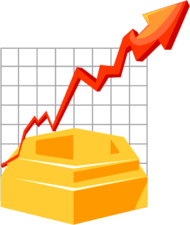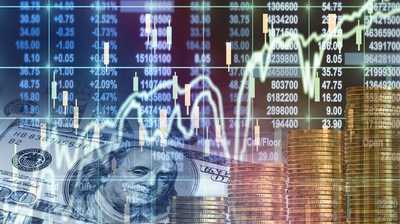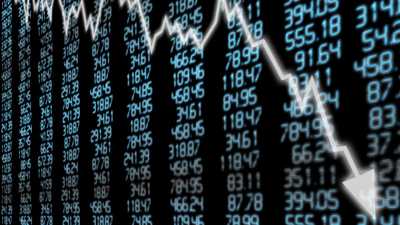| Home | About | Archives | RSS Feed |

@theMarket: Investors Reach for New Highs
 |
The stock market won't quit. It has been on a tear since the day after Christmas. It feels like it wants to keep climbing. That would be a fairly simple feat at this point, since we are only a percent or so away from regaining those historical highs. What will happen once we get there.?
You may ask why am I so confident that the markets won't just give up the ghost right here, right now? A look under the hood at the underlying sectors that make up the market indices gives me a clue. Let's take the semiconductor sector. Throughout the last year or more, semiconductors, a sub-segment of the technology area of the market, have led stocks higher (and lower) time and time again.
Semiconductors made a new all-time high this week. That usually precedes a similar move in the major indices. In the case of the NASDAQ, we are within spitting distance of the old highs.
Other sectors, such as the Transportation Index — trains, planes, railroads, etc. — is nowhere near their historical highs, but that's not unusual. Another positive indicator is that just about all sectors are participating in this rally. The same is true overseas, where even the weak sister of the world, the Eurozone, is witnessing good gains within the European stock markets.
Over the last month, as readers are aware, I have repeatedly cautioned that somewhere out there lurks an expected pullback. Remember, we should expect 2-3 such pullbacks in the stock market each year at a minimum. It is the price of doing business in the stock market. A decline of as much as 9-10 percent would not be surprising, although I expect the next drop won't be of that magnitude.
In any case, as the markets climb, more and more equity experts that I respect are calling for a time out for the markets. Ned Davis, for example, runs a global research shop that is highly respected. He has a good number of years under his belt calling the twists and turns of the market. In his April research report he recommended that, "we would hold off adding equity allocation until a correction has taken place."
Davis worries that global fundamentals are deteriorating. "We will need to see evidence of improving fundamentals" before getting bullish again. Ned also points out that there has been a dangerous rise in complacency. The Ned Davis global sentiment indicators are registering the highest levels of optimism on record, dating back to 2002.
The US Advisory Sentiment Indicator, while not as high as the Ned Davis Index, still registered its highest reading in nine straight weeks of gains. It now stands at 54.8 percent, just shy of 55 percent, which indicates an elevated level of risk for the stock market.
Remember, however, that the investor sentiment contrary indicator is not the final say in whether the markets continue their run. We are now in the midst of the first quarter earnings season. So far, many of the company reports are coming in better than expected. As a result, despite the cautionary technical signals popping up in the markets, earnings and revenue "beats" are providing support for the bulls, at least for now.
My advice is to just stay the course, since timing a pullback and getting back in would be just too tricky in this market. You would have more luck in Las Vegas, if you want to gamble.
Bill Schmick is registered as an investment adviser representative and portfolio manager with Berkshire Money Management (BMM), managing over $400 million for investors in the Berkshires. Bill's forecasts and opinions are purely his own. None of the information presented here should be construed as an endorsement of BMM or a solicitation to become a client of BMM. Direct inquiries to Bill at 1-888-232-6072 (toll free) or email him at Bill@afewdollarsmore.com.
@theMarket: Earnings Season Cause Markets to Surge
 |
After a week of low volume consolidation, all three averages broke higher on Friday. The bulls are still in charge and seem determined to push stocks back to their all-time highs.
A trigger could be this year's first quarter earnings season, which is upon us, some of the multi-center banks reported today. They did not disappoint, beating estimates handily and expectations are that most of the big banks will also beat earnings estimates. That won't be too difficult to do given that earnings estimates have been down-graded not once, but twice, over the last three months.
Overall, the Street is expecting companies that comprise the S&P 500 Index to report a decline in earnings this quarter (anywhere between 2.5 to 4 percent). As such, it won't take much financial engineering for companies to beat these low-ball estimates. With that same index less than 1 percent from its all-time highs, I would expect that next week we should see that level at least touched, if not broken on the upside.
Be advised that the S&P 500 Index has been up 10 out of the last 11 days. That is an unusual performance, but it doesn't mean that string of gains needs to be broken any time soon. On the contrary, stocks could climb and climb until the last buyer has committed to the market before falling. It usually happens that way when the bull becomes a thundering herd.
But it is not earnings that are propelling the markets higher, it is the Fed's easy-money policy stance. As long as that program remains, stock prices will be supported both here and abroad. Overseas, just about every central bank is singing off the same song sheet by lowering interest rates and dumping more money into their financial markets in an effort to prop up their slowing economies as best they can.
Here at home, President Trump has taken to the airways once again, demanding our own central bank cut interest rates, while providing more stimulus to the economy and financial markets. I don't underestimate his power to bend the central bankers to his will. Trump has forced a new political era in this country where the rules and regulations of the past seem to be falling by the wayside on a daily basis.
I couldn't help but notice last week, the April 8th piece in Barron's, a well-regaraded business and investment newspaper. "Is the bull unstoppable?" the editorial team asked, in a huge front-page headline. They went on to write "And just the fact that we're asking the question — on the cover of Barron's, no less — could be a contrarian indicator signaling that the market has truly topped."
They recognize that many times in the past, when a major media publication splashes a story like that on their cover page, a correction, or even a bear market, develops within a short period of time. If you couple this article with yet another increase in bullish sentiment of the Investors Intelligence Advisors Sentiment poll, which came in at 53.9 percent (the highest reading since last October and another contrarian indicator), readers should not be surprised if sometime soon we see a 4-5 percent hit to the averages.
So what? All it would mean for the markets is a much-needed correction before making even higher highs in the months to come. Of course, that forecast is largely dependent upon a trade deal with China by May. The negotiations, according to the White House, are progressing favorably.
The president, however, is still hedging his bets. The word "if" continues to come up whenever Trump is asked about the progress in the U.S./China trade deal. Is that simply a negotiating ploy, or is he truly worried about successfully concluding a deal?
Another potential positive for the markets and the economy might surface if the president can make a deal with the Democrats in furthering a U.S. infrastructure initiative. Speaker Nancy Pelosi will be meeting soon with the president on the subject. It is one of the few areas that both parties can legitimately find common ground. Whether they can get beyond the concept stage, however, remains to be seen. In the meantime, stay invested.
Bill Schmick is registered as an investment adviser representative and portfolio manager with Berkshire Money Management (BMM), managing over $400 million for investors in the Berkshires. Bill's forecasts and opinions are purely his own. None of the information presented here should be construed as an endorsement of BMM or a solicitation to become a client of BMM. Direct inquiries to Bill at 1-888-232-6072 (toll free) or email him at Bill@afewdollarsmore.com.
@theMarket: Markets on a Tear
 |
As fearful as investors were back in December, the greedier they have become in April. Investor sentiment is climbing, interest rates are falling, and the Fed is on hold. All we need to push the markets even higher is a trade deal with China. It's coming.
The S&P 500 Index has tacked on a hundred points in nine days. The all-time record highs for that index is at 1,940 less than 50 points away. That index has been up seven days in a row. The Dow up 6 out of 7. Last week's worry, the inverted yield curve, which occupied everyone's attention, is a barely remembered footnote in buyers rush to own stocks.
Of course, there are warning signs sprouting up throughout the markets. The Algos and computer-driven "Bots" are pushing the indexes beyond their limits. Plenty of strategists are warning that the markets have come too far, too soon. They are probably right, but they were probably right one hundred points ago.
If we all know this, then why not get out while the getting is good? The simple answer is no one knows where to get back in. You might say "I will wait until equities become low enough to offer fair value." The problem is that no one knows what that means anymore.
We live in an environment where markets are pushed to extremes without much, if any, fundamental reason. Markets go higher "just because." And if that is the case, there is no telling when the flipside of these gains will occur. Every day there is a 50/50 chance that stocks will continue higher, but the same probability that they will go lower.
Plenty of people have called me who are now worried about how high the market's have climbed. They have made 18% or so in a short time and don't want to lose it. But in their next breath, they caution me against selling any of their funds "until the market looks like it is going to pull back."
If the truth be told, every day of the last two weeks, around lunchtime, the markets looked like that. But instead, during the last hour of trading, stocks recovered losses and moved even higher. Honestly, folks, if you are still operating within that mindset, you need to change your thinking. Please understand that the markets no longer conform to behavior patterns that may have worked for you a decade or more ago.
The bears will tell you that with the economy slowing, the yield curve inverting (last week's argument), and the likelihood that earnings will probably be negative in this year's first quarter, that the risk of a market decline is quite high. I do not dispute that.
However, with a Chinese/U.S. trade deal possibly just around the corner (2-4 weeks away), do you really want to miss out on the market's potential to celebrate? Then there is the president's new message to the Federal Reserve Bank that it needs to start another round of quantitative stimulus. Who knows whether the Fed will cave-in again and do the president's bidding?
As you know, I have been monitoring investor sentiment as an important contrary indicator for the markets. Wherever I look, that bullish (greed) sentiment is rising to levels which reflect extreme optimism. That's almost always a signal that we are in for a pullback. The question is when.?
John Maynard Keynes once said that "markets can remain irrational far longer than you can stay solvent." My advice: don't try to game this market, stay invested, and if a decline occurs, take your lumps because stocks will most likely recover and continue upward.
Bill Schmick is registered as an investment adviser representative and portfolio manager with Berkshire Money Management (BMM), managing over $400 million for investors in the Berkshires. Bill's forecasts and opinions are purely his own. None of the information presented here should be construed as an endorsement of BMM or a solicitation to become a client of BMM. Direct inquiries to Bill at 1-888-232-6072 (toll free) or email him at Bill@afewdollarsmore.com.
@theMarket: Does the Fed Know Something We Don't?
 |
Sometimes too much good news can be interpreted badly. Take the U.S. central bank's about face on monetary policy late last year. That was good news and investors responded by bidding the stock market up by 20 percent. But this week we may have received even better news, or did we?
The Fed did more than met investors' expectation this week at the central bank's monthly Federal Open Market Committee meeting. Chairman Jerome Powell indicated that there would be no more interest rate hikes for the remainder of the year (after saying back in December that two rate hikes were on the table for 2019). There was even some discussion that a rate cut might be possible, if conditions merited such a move.
One would have thought that would send the markets flying, and they did, at least on Thursday. Friday, however, the opposite occurred. Granted, the reaction could simply be dismissed as a "sell on the news" moment or algos playing their daily games. If so, nothing more needs to be said. But I ask myself — why would Powell and the Fed be contemplating a rate cut?
The news startled some analysts and left them asking questions. Is the economy weaker than most suspect? Has the slow-down in the global economy infected the U.S. as well? Afterall, the Fed did lower their forecast for GDP growth this year from 2.3 percent to 2.1 percent, but it is still growing, or is it?
As most economists know, the economy is getting a little long in the tooth; we call it a "late cycle" market. One of the reasons you might want to cut rates at this point would be if you expected the economy to slip into recession fairly soon.
There is certainly a huge discrepancy between the Fed's forecast and that of the Trump administration. In his budget for 2020, Donald Trump is forecasting 3.2 percent GDP growth this year. Given his tweets about the Fed, that is understandable. He believes that the only problem with the economy is the Fed. He does not believe they are in touch with the market or understand things like trade wars and a strong dollar. Investors are hoping that he is right. Time will tell if the Fed knows more than we do.
In the meantime, stocks continue to climb. As I wrote last week, with the world's central banks in an easing mode, stocks are benefiting from all this monetary stimulus just like they have for the past decade. Investor sentiment continues to move higher as well with the latest readings indicating 53.9 percent of investors bullish — the highest level since Oct. 1, 2018. That is the fifth straight reading above 50 percent, which is usually a sign that some caution is called for in investing.
However, the percentage of bulls are still much lower than the 61.8 percent bullish level that was registered when the stock market hit record highs back in September of last year. As a contrarian indicator, sentiment is a useful tool, but only one in my bag of tricks. Clearly, we have had a great run since the lows in December with hardly a pullback to speak of. We could easily decline a couple of percent at any time
As long as we held the 2,800 level, any sell-off would set us up to make a run at the 2,900 level on the S&P 500 Index. If that were the case, it would mean that we not only erased all of the losses of 2018 but would be looking at an almost double-digit return for the stock market year to date. That's quite impressive, given that we are not even in the second quarter of 2019 yet.
But I don't want to get ahead of myself. Just be grateful you hung in there through the fourth quarter of last year, and by all means, ignore the noise and negativity. Stay invested.
Bill Schmick is registered as an investment adviser representative and portfolio manager with Berkshire Money Management (BMM), managing over $400 million for investors in the Berkshires. Bill's forecasts and opinions are purely his own. None of the information presented here should be construed as an endorsement of BMM or a solicitation to become a client of BMM. Direct inquiries to Bill at 1-888-232-6072 (toll free) or email him at Bill@afewdollarsmore.com.
@theMarket: Pick Your Poison
 |
Investors were greeted on Friday with two nasty surprises. Both occurred in February. Chinese exports dropped by 20.7 percent, while in the U.S., the nation added a dismal 20,000 jobs. As you might expect, the stock market did not take the news well.
What really spooked traders was how far apart these numbers were to expectations. Over here, we were expecting 180,000 jobs to be added to the payroll number. In China, where the economy had been expected to weaken, exports had been forecasted to decline by 6 percent, versus the prior year.
Before the ink had dried on the jobs data, the administration was already sending their point man on the economy, Larry Kudlow, the director of the National Economic Council, on television to assure Wall Street that the February data was "fluky" and should be ignored.
As for China, investors there took the Shanghai Composite down by 4.4 percent overnight. Japan dropped half of that (minus-2 percent), even after the government said its economy grew by 1.9 percent in the fourth quarter of last year. It also didn't help that the European Central Bank lowered its forecasts Thursday for growth in the Eurozone and announced more stimulus measures to support the economy.
Over the last two weeks, I have been warning readers to expect a pullback in the markets, nothing too serious, but maybe a 3-5 percent decline. If I were to take a guess, we could see the S&P 500 Index hit 2,700 or so, before we mellow out. From there, it depends on how low those crazy algo trading machines decide to take us. Where is John Connor when you need him?
By now you should expect these consolidations especially after watching the indices free fall in the last quarter of 2018 and then climb by almost 20 percent from their December lows.
There has also been a growing skepticism over the China/U.S. trade deal. Despite my own skepticism, investors were happy to drink the White House "Kool-Aid" on the timing of a breakthrough announcement. It was first thought the deal would be announced three weeks ago. It was then pushed back after the Chinese team of negotiators returned to Beijing with nothing done. Last week, negotiations were "moving along very nicely," according to the president.
On Thursday, The New York Times reported that negotiators were still trying to lock down details and that Chinese officials "were wary about the final terms" because of Trump's penchant for making last-minute changes over the heads of his negotiators. But, of course, they would say that.
On Friday, Trump, when asked about the deal on the South Lawn, sounded a little less certain. He predicted "a very big spike" in the stock market "as soon as these trade deals are done, if they get done, and we're working with China. We'll see what happens."
Whether we actually do see a spike in the stock market (and for how long) depends on what happens next. Readers might recall that I believed that much of any potential upside for stocks based on a breakthrough trade deal was already discounted by market participants. When announced, it would likely be a "sell on the news" event.
If, on the other hand, the markets continue to pullback here by several percent, and then a really good deal is announced (as opposed to something which simply saves face), then the president might be right. So how do you play it? Simple: do nothing, stay invested, and strap in. The ride should be bumpy.
Bill Schmick is registered as an investment adviser representative and portfolio manager with Berkshire Money Management (BMM), managing over $400 million for investors in the Berkshires. Bill's forecasts and opinions are purely his own. None of the information presented here should be construed as an endorsement of BMM or a solicitation to become a client of BMM. Direct inquiries to Bill at 1-888-232-6072 (toll free) or email him at Bill@afewdollarsmore.com.

